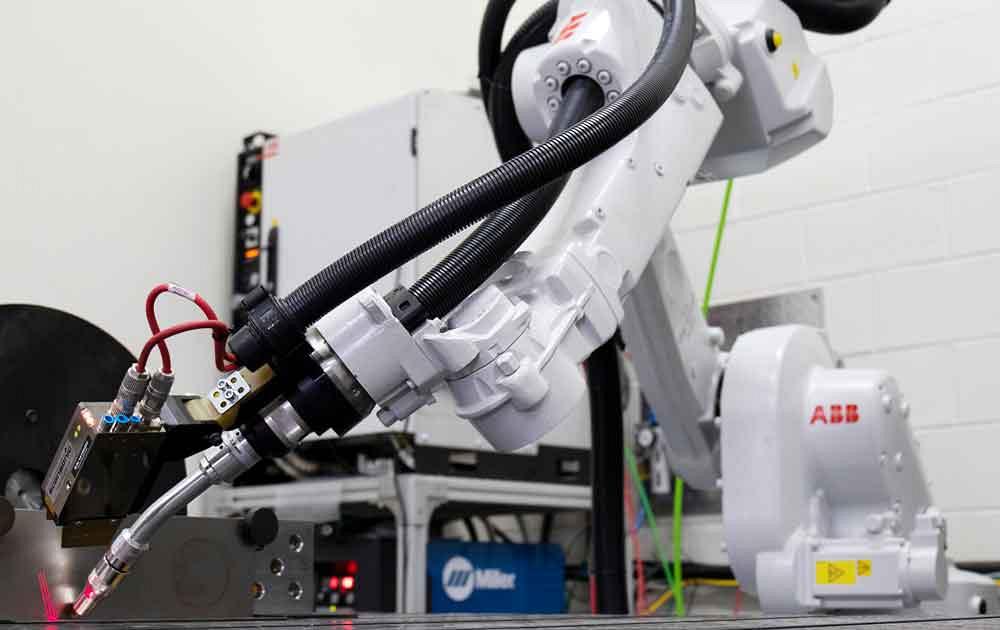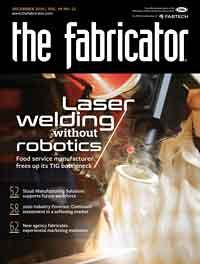Editor-in-Chief
- FMA
- The Fabricator
- FABTECH
- Canadian Metalworking
Categories
- Additive Manufacturing
- Aluminum Welding
- Arc Welding
- Assembly and Joining
- Automation and Robotics
- Bending and Forming
- Consumables
- Cutting and Weld Prep
- Electric Vehicles
- En Español
- Finishing
- Hydroforming
- Laser Cutting
- Laser Welding
- Machining
- Manufacturing Software
- Materials Handling
- Metals/Materials
- Oxyfuel Cutting
- Plasma Cutting
- Power Tools
- Punching and Other Holemaking
- Roll Forming
- Safety
- Sawing
- Shearing
- Shop Management
- Testing and Measuring
- Tube and Pipe Fabrication
- Tube and Pipe Production
- Waterjet Cutting
Industry Directory
Webcasts
Podcasts
FAB 40
Advertise
Subscribe
Account Login
Search
Automated welding guidance systems improve heavy fabrications
More robots expected to hit shop floors as companies struggle to find welders
- By Dan Davis
- Updated May 5, 2023
- December 14, 2019
- Article
- Automation and Robotics
The trend of more high-mix, low-volume manufacturers adopting welding automation is hard to ignore. The technology has become more affordable, and programming of robots has become much easier. When shops can’t find welders, they sometimes feel like they have no choice but to look at robots.
Fabricators that frequently work with plate and large weldments share some of the same struggles finding welders as their counterparts on the precision sheet metal side of metalworking. They, however, may not have believed they had much of a choice in terms of automated welding because their workpieces most likely don’t fit into standard robotic welding cells and working with heavy fabrications can be tricky because plate has a way of absorbing heat and distorting during welding.
But in the age of automation, change doesn’t slow. The emergence of guidance systems that are both affordable and accurate has helped to make automated welding systems more viable for heavy fab shops.
Big-time Automated Welds
Matt Conklin, a welding application engineer with ABB, is pretty excited to share some details about a recent project with an automation integrator. This project was big in scope and big in potential.
The job called for a robot to make a gas metal arc weld over 10 feet on 0.25-inch steel. As the lap joint weld was made, a laser tracker kept tabs on the seam to ensure that the gaps were filled. That was almost a necessity, Conklin explained, because exposing that material thickness to a heat source in the span of time needed to cover 10 ft. can distort the weldment. It’s not unusual to see a gap deviate as much as 0.5 in. or so in this type of heavy fabrication welding application.
The use of guidance tracking in automated welding, however, can alleviate the need for precise fixturing, which takes time and talent to create.
“Instead of putting money into your fixturing, you can put money into the technology to keep the weld straight and in the joint where it counts,” Conklin said.
“Through this type of through-the-arc seam tracker or an optical tracker, you can actually sense where the joint is,” he said. “It’ll sense an opening, and it’ll measure that gap. Then preset conditions in the control software help to guide the torch, and as the root opening grows, the weave is going to get larger to fill the gap.”
This type of automation now makes sense not just for manufacturers of high-volume products, but also the shops that live off of high-mix, low-volume fabricating work. Modular welding tables allow fabricators to create fixturing quickly for new jobs, and the tolerances do not have to be as exact, because guidance systems can make up for those inconsistencies in gaps.
In today’s modern fabricating world, a fabricator can program a new automated welding job offline, create the fixture using the modular table and tooling, present the part to a robot, and be up and running in hours.
“We are now able to adapt really quickly to these types of manufacturing environments,” Conklin said.
What the Robot Sees
David Bruce, engineering manager for the general industry and automotive segment, FANUC America Corp., has spent a lot of time working with vision systems in material handling applications, but he also sees great potential for them in welding. The reason is simple: Robots are good at doing the same thing consistently over multiple iterations, and vision systems enable that even when variabilities, such as gap inconsistencies, are present.
Next-generation vision-guided robotic systems will primarily use 3D technology because it is becoming more affordable, Bruce said. They also offer clarity of the joint that can’t be duplicated with 2D technology.
“You can imagine two pieces of metal on top of each other. You don’t really see the contrast or where one part begins and the other part ends,” he said. “But if you go with a 3D vision system, you can create a point cloud to determine the X, Y, and Z dimension of the part, and you get a very good resolution. At that point it becomes very obvious where the joint is.”
When the welding robot can see, it can do a better job of making consistent welds. What if it could learn? Bruce said machine learning, coupled with vision systems, can take robotic welding to another level.
To illustrate the potential of machine learning in welding applications, Bruce used the example of a welded nut. Of course, a manufacturer wants to ensure that the nut is welded in the right location and that the weld is done correctly. In the past, such a quality check may have been left up to a quality technician or even the welder in some circumstances. With today’s technologies, a 3D vision-guided robot can check on the exact positioning and provide images of the welding process and final joint. (The welding process simply obliterates the ability of a 2D vision system to capture usable images. In the end, you end up with images of black marks around the nut.) Artificial intelligence built into the software that runs the welding cell then is able to give a go/no-go indication on the welded nut.
“Machine learning is now being leveraged for all kinds of different applications,” Bruce said. The newest generation of iRVision, FANUC America’s vision system line for its robots, comes with a new artificial intelligence-powered errorproofing tool, he added, which can be used over a wide variety of industries, from industrial applications to material handling in warehousing situations.
So if metal fabricators look into their crystal balls they might see a future where robotic welding doesn’t involve fixtures at all. A cell could have material handling robots that pick up separate metal parts, present them to a vision system to be scanned, and wait for instructions from the artificial intelligence system on how to present the parts together to create the ideal merge position. From there a welding robot can enter the picture to complete the joint, while a vision system captures images to verify weld quality.
“That type of thinking gets a lot of people excited because it can lead to a huge cost savings,” Bruce said.
Automated welding Guidance Systems Coming to a Shop Near You
Robotic welding systems and their accompanying guidance systems are no longer options for only the largest of manufacturers. Conklin said that recent tradeshows have provided him with more automation discussions with small and medium-sized job shops looking for welding assistance because they simply can’t find the folks to keep up with their current workload or new opportunities.
As these automated welding cells are able to deliver more repeatable, bulletproof results, they’ll find homes in places where they were hardly ever seen before, such as heavy fabricating operations. It’s just a matter of fabricators pushing automation companies and their integrator partner companies to spend more time on manufacturing applications.
About the Author

Dan Davis
2135 Point Blvd.
Elgin, IL 60123
815-227-8281
Dan Davis is editor-in-chief of The Fabricator, the industry's most widely circulated metal fabricating magazine, and its sister publications, The Tube & Pipe Journal and The Welder. He has been with the publications since April 2002.
Related Companies
subscribe now

The Fabricator is North America's leading magazine for the metal forming and fabricating industry. The magazine delivers the news, technical articles, and case histories that enable fabricators to do their jobs more efficiently. The Fabricator has served the industry since 1970.
start your free subscription- Stay connected from anywhere

Easily access valuable industry resources now with full access to the digital edition of The Fabricator.

Easily access valuable industry resources now with full access to the digital edition of The Welder.

Easily access valuable industry resources now with full access to the digital edition of The Tube and Pipe Journal.
- Podcasting
- Podcast:
- The Fabricator Podcast
- Published:
- 04/30/2024
- Running Time:
- 53:00
Seth Feldman of Iowa-based Wertzbaugher Services joins The Fabricator Podcast to offer his take as a Gen Zer...
- Industry Events
16th Annual Safety Conference
- April 30 - May 1, 2024
- Elgin,
Pipe and Tube Conference
- May 21 - 22, 2024
- Omaha, NE
World-Class Roll Forming Workshop
- June 5 - 6, 2024
- Louisville, KY
Advanced Laser Application Workshop
- June 25 - 27, 2024
- Novi, MI
































